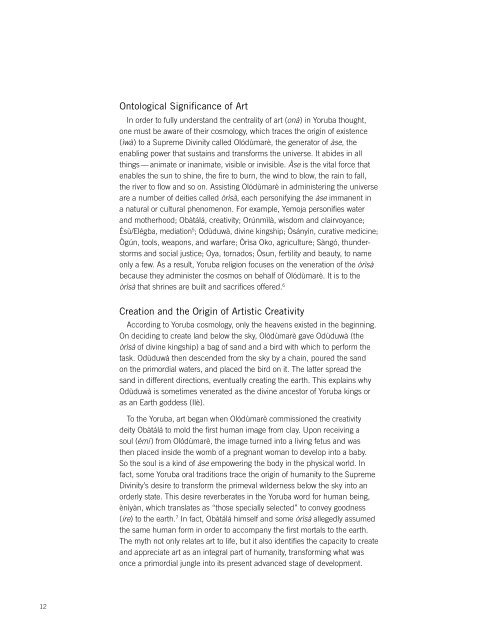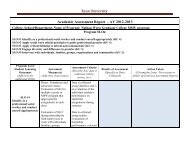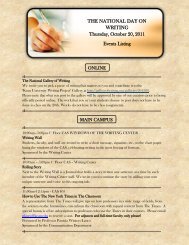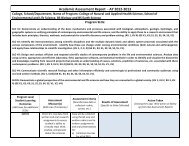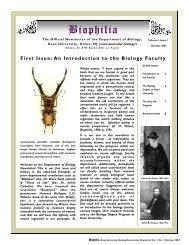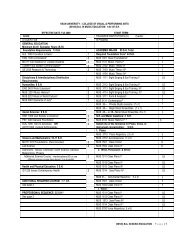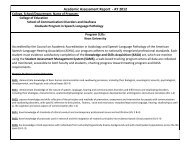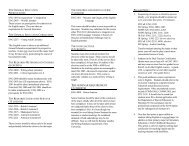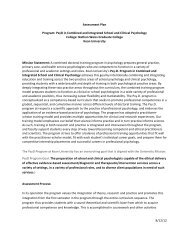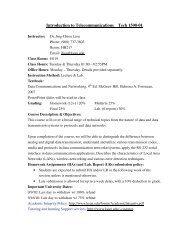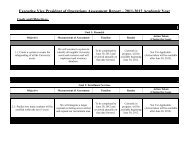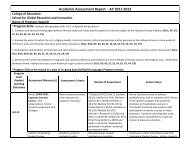Embodying the Sacred in Yoruba Art - Kean University
Embodying the Sacred in Yoruba Art - Kean University
Embodying the Sacred in Yoruba Art - Kean University
Create successful ePaper yourself
Turn your PDF publications into a flip-book with our unique Google optimized e-Paper software.
12<br />
Ontological Significance of <strong>Art</strong><br />
In order to fully understand <strong>the</strong> centrality of art (onà) <strong>in</strong> <strong>Yoruba</strong> thought,<br />
one must be aware of <strong>the</strong>ir cosmology, which traces <strong>the</strong> orig<strong>in</strong> of existence<br />
(ìwà) to a Supreme Div<strong>in</strong>ity called Olódùmarè, <strong>the</strong> generator of àse, <strong>the</strong><br />
enabl<strong>in</strong>g power that susta<strong>in</strong>s and transforms <strong>the</strong> universe. It abides <strong>in</strong> all<br />
th<strong>in</strong>gs — animate or <strong>in</strong>animate, visible or <strong>in</strong>visible. Àse is <strong>the</strong> vital force that<br />
enables <strong>the</strong> sun to sh<strong>in</strong>e, <strong>the</strong> fire to burn, <strong>the</strong> w<strong>in</strong>d to blow, <strong>the</strong> ra<strong>in</strong> to fall,<br />
<strong>the</strong> river to flow and so on. Assist<strong>in</strong>g Olódùmarè <strong>in</strong> adm<strong>in</strong>ister<strong>in</strong>g <strong>the</strong> universe<br />
are a number of deities called òrìsà, each personify<strong>in</strong>g <strong>the</strong> àse immanent <strong>in</strong><br />
a natural or cultural phenomenon. For example, Yemoja personifies water<br />
and mo<strong>the</strong>rhood; Obàtálá, creativity; Orúnmìlà, wisdom and clairvoyance;<br />
Èsù/Elégba, mediation 5 ; Odùduwà, div<strong>in</strong>e k<strong>in</strong>gship; Òsányìn, curative medic<strong>in</strong>e;<br />
Ògún, tools, weapons, and warfare; Òrìsa Oko, agriculture; Sàngó, thunderstorms<br />
and social justice; Oya, tornados; Òsun, fertility and beauty, to name<br />
only a few. As a result, <strong>Yoruba</strong> religion focuses on <strong>the</strong> veneration of <strong>the</strong> òrìsà<br />
because <strong>the</strong>y adm<strong>in</strong>ister <strong>the</strong> cosmos on behalf of Olódùmarè. It is to <strong>the</strong><br />
òrìsà that shr<strong>in</strong>es are built and sacrifices offered. 6<br />
Creation and <strong>the</strong> Orig<strong>in</strong> of <strong>Art</strong>istic Creativity<br />
Accord<strong>in</strong>g to <strong>Yoruba</strong> cosmology, only <strong>the</strong> heavens existed <strong>in</strong> <strong>the</strong> beg<strong>in</strong>n<strong>in</strong>g.<br />
On decid<strong>in</strong>g to create land below <strong>the</strong> sky, Olódùmarè gave Odùduwà (<strong>the</strong><br />
òrìsà of div<strong>in</strong>e k<strong>in</strong>gship) a bag of sand and a bird with which to perform <strong>the</strong><br />
task. Odùduwà <strong>the</strong>n descended from <strong>the</strong> sky by a cha<strong>in</strong>, poured <strong>the</strong> sand<br />
on <strong>the</strong> primordial waters, and placed <strong>the</strong> bird on it. The latter spread <strong>the</strong><br />
sand <strong>in</strong> different directions, eventually creat<strong>in</strong>g <strong>the</strong> earth. This expla<strong>in</strong>s why<br />
Odùduwà is sometimes venerated as <strong>the</strong> div<strong>in</strong>e ancestor of <strong>Yoruba</strong> k<strong>in</strong>gs or<br />
as an Earth goddess (Ilè).<br />
To <strong>the</strong> <strong>Yoruba</strong>, art began when Olódùmarè commissioned <strong>the</strong> creativity<br />
deity Obàtálá to mold <strong>the</strong> first human image from clay. Upon receiv<strong>in</strong>g a<br />
soul (èmí ) from Olódùmarè, <strong>the</strong> image turned <strong>in</strong>to a liv<strong>in</strong>g fetus and was<br />
<strong>the</strong>n placed <strong>in</strong>side <strong>the</strong> womb of a pregnant woman to develop <strong>in</strong>to a baby.<br />
So <strong>the</strong> soul is a k<strong>in</strong>d of àse empower<strong>in</strong>g <strong>the</strong> body <strong>in</strong> <strong>the</strong> physical world. In<br />
fact, some <strong>Yoruba</strong> oral traditions trace <strong>the</strong> orig<strong>in</strong> of humanity to <strong>the</strong> Supreme<br />
Div<strong>in</strong>ity’s desire to transform <strong>the</strong> primeval wilderness below <strong>the</strong> sky <strong>in</strong>to an<br />
orderly state. This desire reverberates <strong>in</strong> <strong>the</strong> <strong>Yoruba</strong> word for human be<strong>in</strong>g,<br />
ènìyàn, which translates as “those specially selected” to convey goodness<br />
(ire) to <strong>the</strong> earth. 7 In fact, Obàtálá himself and some òrìsà allegedly assumed<br />
<strong>the</strong> same human form <strong>in</strong> order to accompany <strong>the</strong> first mortals to <strong>the</strong> earth.<br />
The myth not only relates art to life, but it also identifies <strong>the</strong> capacity to create<br />
and appreciate art as an <strong>in</strong>tegral part of humanity, transform<strong>in</strong>g what was<br />
once a primordial jungle <strong>in</strong>to its present advanced stage of development.


